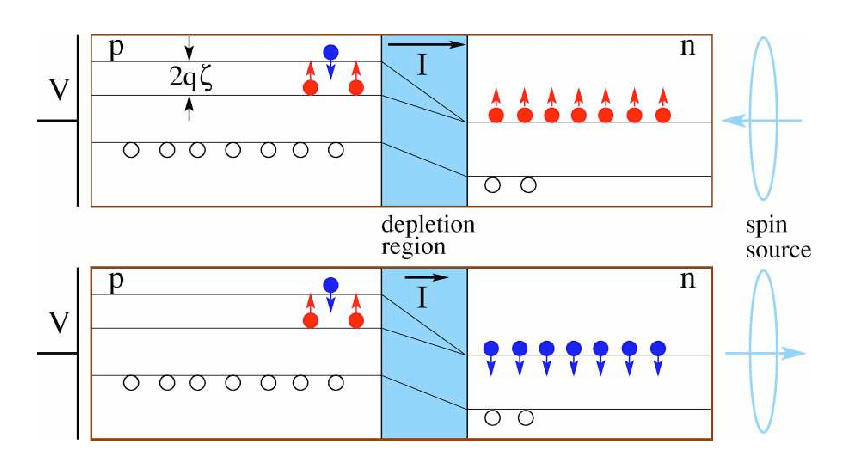
|
|
| Coworker: | K. Gärtner, A. Glitzky, Th. Koprucki |
| Support: | Th. Koprucki is financially supported by the SFB 787 Halbleiter-Nanophotonik in project B4. |
Description
Semiconductor spintronic refers to the phenomena of spin-polarized transport in semiconductors. The goal is to find effective ways of controlling electronic properties such as current or accumulated charge, by spin or magnetic field as well as of controlling spin or magnetic properties by electric currents or gate voltages. From the technological point of view an efficient spin injection, slow spin relaxation and reliable spin detection are the important requirements. The aim is to develop practical device schemes what would enhance the functionality of the current charge based electronics. Examples are magnetic diodes, spin LEDs or a spin field effect transistor, which would change his logic state from ON to OFF by flipping the orientation of a magnetic field.
We introduce a spin-polarized drift-diffusion model for semiconductor spintronic devices. This coupled system of continuity equations and a Poisson equation with mixed boundary conditions in all equations has to be considered in heterostructures. We give a weak formulation of this problem and prove an existence and uniqueness result for the instationary problem. If the boundary data is compatible with thermodynamic equilibrium the free energy along the solution decays monotonously and exponentially to its equilibrium value. In other cases it may be increasing but we estimate its growth. Moreover we give upper and lower estimates for the solution.
In 3D we prove the existence and boundedness of steady states. If the Dirichlet conditions are compatible or nearly compatible with thermodynamic equilibrium the solution is unique. The same properties are obtained for a space discretized version of the problem: Using a Scharfetter-Gummel scheme on 3D boundary conforming Delaunay grids we show existence, boundedness and, for small applied voltages, the uniqueness of the discrete solution.
Results
-
A. Glitzky ,
K. Gärtner
Existence of bounded steady state solutions to spin-polarized drift-diffusion systems,
SIAM J. Math. Anal. 41 (2010) pp. 2489-2513,
WIAS Preprint 1357 (2008) -
A. Glitzky
Analysis of a spin-polarized drift-diffusion model,
Adv. Sci. Appl.18 (2008) pp. 401-427,
WIAS Preprint 1300 (2008) -
A. Glitzky
Analysis of spin-polarized drift-diffusion models,
in: PAMM (Proceedings in Applied Mathematics and Mechanics), Volume 8, Issue 1, Special Issue: GAMM Annual Meeting 2008, Bremen, Wiley-VCH Verlag, Weinheim, 2008, pp. 10717-10718. -
Poster
Semiconductor models with spin-polarization - Talks
-
Talk Existence of bounded steady state solutions to spin-polarized drift-diffusion systems
Workshop on Drift Diffusion Systems and Related Problems: Analysis, Algorithms and Computations, WIAS, 2010,
Berlin, 2010 March 25 -
Talk Analysis of Spin-Polarized Drift-Diffusion Models
GAMM Annual Meeting 2008,
Bremen, 2008 April 1
Up